Body
Abdominoplasty (Tummy Tuck)
A tummy tuck is a major surgical procedure in which excess skin and fat are removed from the lower abdomen and the muscles of the abdomen wall are tightened. This procedure can drastically reduce the appearance of a protruding abdomen. The procedure is particularly helpful to women who, through multiple pregnancies have stretched their abdomen so far that it does not return to it’s normal shape. A tummy tuck is also helpful for those who have lost a significant amount of weight but still possess loose, sagging skin. Tummy tucks are often performed in conjunction with liposuction. The best candidates for an abdominoplasty are men or women in good health and relatively good shape, but are bothered by a large fat deposit or loose abdominal skin that does not respond to diet or exercise. Those who are considering losing a significant amount of weight, or are planning future pregnancies, may want to consider waiting before undergoing the tummy tuck procedure.
During the tummy tuck procedure a horizontal incision is made just above the pubic area and excess skin and fat is removed from the abdomen. Skin is separated from the abdominal wall. The underlying muscles of the abdominal wall are then tightened. The abdominal skin is then drawn downward and the excess is removed. Some of these risks of tummy tucks include infection and blood clots. These can be treated easily and are rare. Tummy tucks can improve abdominal appearance; however, the procedure has been known to leave scarring. Some scarring can be severe and may require a second operation.
There are other alternatives to the tummy tuck procedure. A mini tummy tuck can be performed, in which only improves the appearance of the abdomen below the navel. During a mini tummy tuck, only a short horizontal incision is made and the skin is separated only between the incision line and the navel. Another alternative is undergoing liposuction in order to remove the abdominal fat. Liposuction can also be performed in conjunction with a tummy tuck. Please consult with your plastic surgeon as to which procedure will best meet your needs.
| Before | After | Before | After |
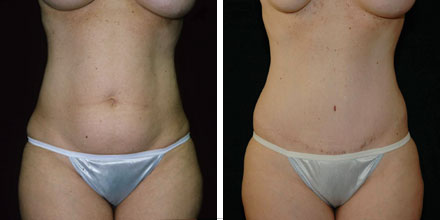 |
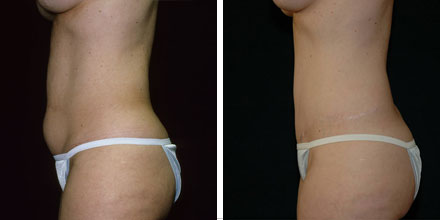 |
||
|
Before
|
After
|
||
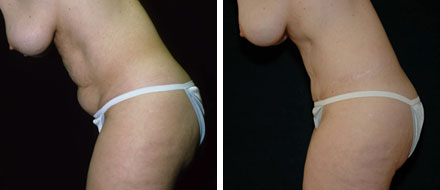 |
|||
AbdominoplastyDescription: 42 y.o. 5’5 ½” 135 lb. with daughters age 3 and 10 yr. The covering over her stomach (abdominal) muscles (the fascia) was stretched by her two pregnancies. Despite sit-ups she always had to “hold her stomach in”. Abdomen bulged above the top of her jeans. Skin laxity about her abdomen prevented performing just liposuction.Tummy tuck surgery (full abdominoplasty) removed all skin and fat from just above her pubic area to just above the belly button (navel). The covering over the muscle was tightened (fascial plication) to give a firmer flatter abdomen. Abdominal skin and fat removed weighed 1 lb. 12 oz (788 gm.). She also underwent liposuction to her hips, inner & outer thigh, knee, and upper arm at the same time.After pictures taken 5 yr. 5 mo. after surgery now 140 lb.Although she had undergone breast augmentation with Dr. Pertsch 8 years before her abdominoplasty and liposuction she felt the abdominoplasty was the best thing she ever did for herself. Jeans fit and looked much better. |
|||
Mini-Tuck with Abdomen Liposuction
| Before | After | Before | After |
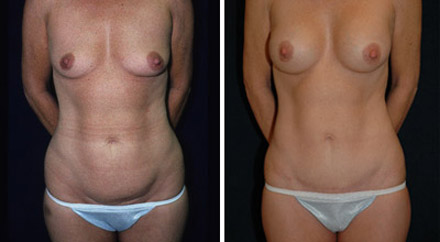 |
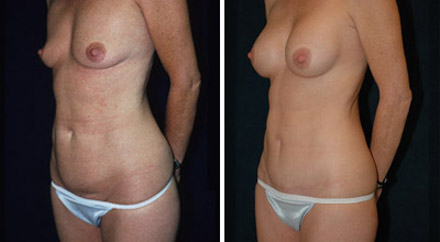 |
||
| Before | After | ||
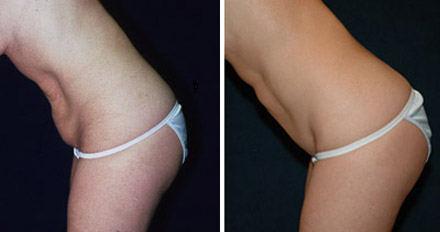 |
|||
Liposuction
Exercise and diet can help make you healthy, as well as help you look lean and muscular. For some individuals, however, it does not always remove those stubborn LFD’s (localized fat deposits). Every individual’s fat distribution and body shape is genetically determined. What this means is that often no amount of diet and exercise will remove these stubborn fat deposits. Even if the individual is at an adequate body weight, they will still posses areas of excess fat. Liposuction is a procedure that can remove fat and fat cells, thus sculpting the body and doing what diet and exercise alone could not. Liposuction is one of the most common cosmetic procedures performed in the United States today. However, even though liposuction is designed to remove fat, it does not replace or serve as a substitute for good diet and exercise.
Lipoplasty, commonly known as liposuction, is a common surgical procedure that removes deposits of excess fat from specific areas of the body, face or neck. Liposuction can be used to slim the hips, thighs, flatten the tummy, shape the calves and ankles or eliminate a double chin.
The best candidates for liposuction are:
- Men and women of normal weight whom mainly want to improve their body shape and contours.
- People with fat deposits that are “trouble areas” where exercise and diet seem not to have any effect.
- People with good elasticity in their skin, so when the fat is removed, they will achieve a smooth appearance.
The areas that liposuction can have the greatest effect on are the abdomen and waist area, the arms, back chin, neck, hips, buttocks, thigh ankles, calves and inner knees.
Patients of any age can undergo the procedure, but those who have greater skin elasticity will achieve the smoothest end result.
During the liposuction procedure, one or more incisions are made near the area to be treated. When possible, the incisions are made within the fold or natural creases in skin. Your doctor will then insert a small hollow tube called a cannula through the incision where he will then penetrate the underlying fat. The cannula is connected to a flexible tubing and suction pump. Your doctor then moves the cannula back and forth thought the fat, vacuuming the fat out through the tube.
The procedure is very common with thousands of patients undergoing the procedure each year with no major complications. However the possibility of risk occurring is always associated with surgery. In rare cases the liposuction procedure has caused severe trauma, particularly when multiple or very extensive areas are suctioned at one time. Other possible complications include fluid accumulation and injury to the skin. Sometimes asymmetry or unevenness may require further treatment.
There are various fat removal techniques available. There is the tumescent technique, in which the fat is pre-injected with a solution of salt water, local anesthetic and small amounts of adrenaline. Another type of procedure is the ultrasound assisted lipoplasty or UAL. This is a two-step procedure that uses ultra sound waves for energy, and liquefies the fat, which is then suctioned out. There are more techniques available, during your consultation, be sure to ask your doctor for more information about the various fat removal techniques.
| Before | After | Before | After |
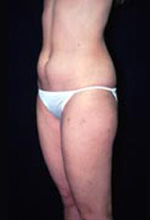 |
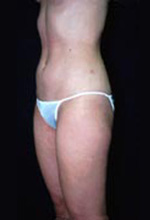 |
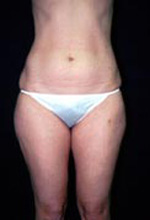 |
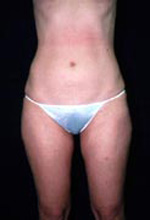 |
LiposuctionDescription: 37 year old mother of 4 yr. old son wished improvement of areas that just would not improve despite dieting and exercise. Her goals of being ‘more comfortable in shorts, bathing suit , and greater comfort being undressed with her husband’ were accomplished. M.D. is 5’5″ tall and weighed 130 lb. before and 130 lb. after. Amount of fat removed: 1300 cc in total (250 cc is about 1 cup). 300 cc abdomen (stomach), 175 cc right hip, 150 cc left hip, 200 cc right outer thigh, 175 cc left outer thigh, 150 right inner thigh, 150 cc left inner thigh. ‘After’ photographs taken 4 months 1 week after surgery. |
|||
Inner Thigh Lift
A thigh lift is a plastic surgery procedure to remove loose skin from the thighs. Successful and sustained massive weight loss can lead to extensive redundancy of skin in the inner thigh area. Constant rubbing together of the redundant inner thigh folds predisposes to areas of skin irritation and infection and interferes with personal hygiene. Clothing may be difficult to fit and there may be psychosocial concerns of a disfigured appearance. Comfort and appearance improve by the plastic surgery procedure known as the thigh lift.
A thigh lift is a surgical procedure performed to tighten the loose and sagging skin around the thighs. Many women and men who have experienced great weight loss are often left with excess skin. This skin can be pulled up and tightened creating a permanent alteration.
| Before | After | ||
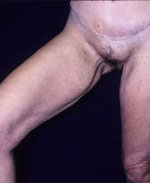 |
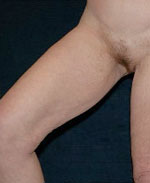 |
||
Labiaplasty
Labia minora are the “inner lips” just outside of the opening to the vagina. Some women may have always had one or both enlarged or redundant. Multiple childbirth’s can also cause stretching. Rarely chronic irritation, hormones, or aging can cause lengthening and drooping.
Excessive labia minora can be uncomfortable, take extra time and attention to maintain proper hygiene or lead to poor hygiene. There can be interference or self-consciousness during sexual intercourse. Asymmetrical or enlarged labia minora may be more uncomfortable or even visible with currently popular tight clothing. Labia majora are seen when bathing attire is worn over absent or closely trimmed pubic hair and may allow labia minora redundancy to be apparent.
Labia reduction (also called labia minora reduction, labial reduction, labiaplasty, labialplasty, or “inner lips” reduction) can reduce the hanging or asymmetrical labia minora yet maintain the normal appearance and clitoral protection. In some cases the clitoral hood may be redundant and also benefit from some reduction. Reduction results in less feeling of “fullness”, can simplify daily hygiene, and reduce self-consciousness or interference during vaginal intercourse.
The procedure involves removing a wedge of protuberant labial tissue leaving enough behind for normal appearance and function. The labial edges are re-approximated with stitches that dissolve on their own. The procedure is best timed right after menses are completed for a given month. Labial reduction can be tailored to individual preference. Most women prefer that labia minora not protrude beyond the labia majora and that some clitoral hood remain to protect the sensitive clitoris. The actual surgery time takes about 1 to 1.5 hours although there can be additional preparation time on the day of surgery. There is a high success rate and low chance of healing or other problems.
Women report that a normal genital appearance greatly enhances self-esteem, physical comfort, and puts the genital appearance issue behind them.
| Before | After |
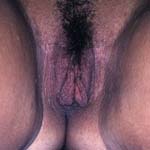 |
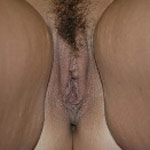 |
Brachioplasty (Upper Arm Skin Tightening / Arm Lift)
The effects of aging on the skin are familiar to all of us. Over time, the skin changes in four ways: it loses thickness, loses elasticity, loses adherence to the underlying tissue, and is affected by gravity. At the same time, the deep layers of fat, muscle and bone thin as well. The amount of elastic tissue and collagen present in the dermis (the deep layer of the skin) also decreases. One area where these changes are especially apparent is the upper arm. An arm lift can lift and tighten up loose skin in the upper arms, resulting in a firmer, more youthful contour.
Gynecomastia
Gynecomastia is an enlargement of the male breasts. This condition is quite common and it affects as many as 40 percent of the male population. Gynecomastia may affect only one or both of the breasts. The majority of the cases have no known cause while the others might be related to the use of drugs or medical conditions. Gynecomastia can be caused by excessive glandular breast tissue, fat, or a combination of the two. For men who feel self-conscious about their oversized breasts, this procedure can help restore self-confidence and appearance.
The best candidates for gynecomastia correction are:
- Healthy, emotionally stable men of any age
- Men who have firm, elastic skin that will reshape well after surgery
Men who are discouraged from gynecomastia correction are:
- Obese or overweight men who have not attempted to correct the problem with diet and exercise
- Individuals who consume excessive amounts of alcohol and / or marijuana.
These drugs along with anabolic steroids may cause gynecomastia.
Gynecomastia correction is usually performed as an outpatient procedure. Your doctor may use local or general anesthesia depending on the extensiveness of your surgery.
View Gallery